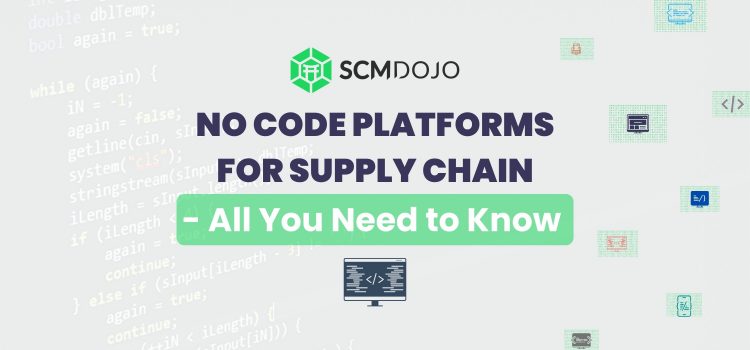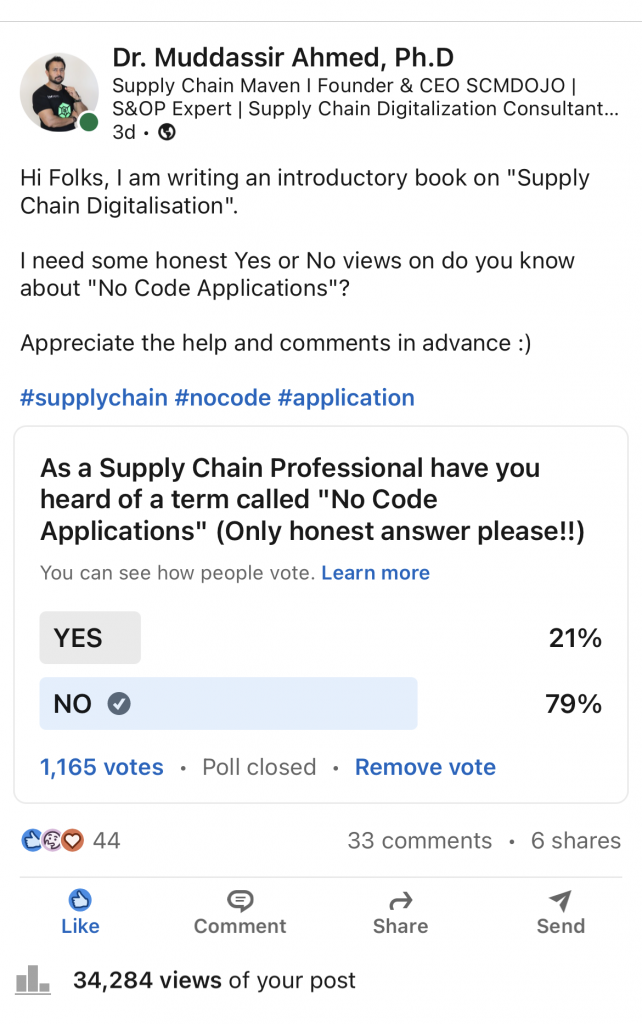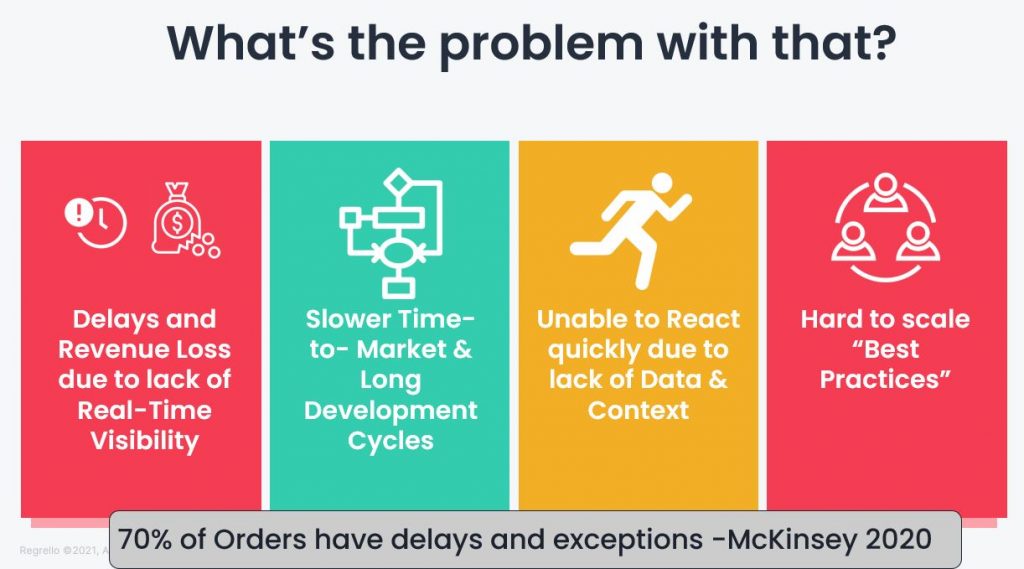Modern enterprises rely on supply chain software to track several activities, including manufacturing and distribution of goods. However, most of these systems were created before web technologies existed or were in their infancy. Many supply chain systems are closed-source, all-in-one, proprietary, expensive, and difficult to customize (read Why ERP Sucks). It is to my surprise more than 79% of supply chain professionals have not heard about the “no-code platform. However, Finance is now Fintech and Marketing is now Digital Marketing. The growth of coding capabilities and accessible resources can help several firms consolidate data sources and create real-time visibility throughout the end-to-end supply chain using no-code development platforms.
To improve the overall efficiency, supply chain management and brands are automating key business processes using no-code platforms. These platforms allow users to create robust apps without coding each detail from scratch. No-code platforms offer a significant improvement over previous techniques employed in developing applications for supply chain automation. The benefits include cost savings and a quick turnaround time from development to implementation.
However, the recent survey I did on LinkedIn tells us that 79% of 1164 supply chain professionals have not heard the term “No-code Applications”. This poll was viewed by 34,284 professionals, which shows the interest and engagement in the topic.
What are No-code Platforms?
No-code platforms are software design systems that allow both technical and non-technical professionals to execute a variety of software demands with zero lines of code. These tools feature a user-friendly interface alongside drag-and-drop features that will enable you to visualize the implementation process and comfortably define the overall business logic.
No-code platforms can also be seen as programming platforms that utilize visual development interfaces to assist non-technical users in creating applications with the assistance of software components that have been integrated easily.
Users, especially non-technical professionals, do not require previous coding experience to create applications using no-code platforms. These platforms are intended to employ easy to use visual development interface to enable everyone, including supply chain professionals, to develop and build applications and software solutions from start to finish. And as a result, accelerating the Supply Chain Digitalization journey.
It may seem too fantastic to be accurate, but non-technical enterprise consumers can now develop full-fledged apps! No-code platforms are not just a concept but a foot transforming the supply chain market.
Benefits of No-code Platforms
No-code platforms are taking industries by storm and creating prospects for businesses seeking application solutions in ways we did not consider possible. The use of no-code platforms essentially shifts how applications are built typically, permitting general users and non-technical professionals to create complex workflows with zero lines of code. Applications developed on No-code platforms are customizable, cost-effective, and secure solutions driven by ideas.
The supply chain and related industries can gain a competitive edge using no-code platforms. Below are some of the most valuable benefits of using no-code platforms:
Here are Some of the Most Useful Benefits of No-code Development.
Reduces Time to Market
Technical developers often choose functionality over speed when it involves enterprise applications. The current application marketplace is highly saturated with supply chain apps and solutions, but the demand for swift delivery and user product experience requires the inclusion of non-technical views.
A no-code platform reduces the time spent on developing applications and allows businesses to leverage the business expertise of their employees. They also enable regular employees to create and see through the building application process with a visual approach of dropping and dragging elements.
No-code platforms deliver rich functionality and the ability to turn applications within the shortest possible time. Supply chain firms can easily get application products into the markets quickly with no-code platforms to meet demands.
Adds Ease in Bridging Communication Gaps.
The average application necessitating additional app development shows some degree of detachment between the supply chain team, eventual customers, and the IT team’s visions on the ideal app. No-code platforms offer a more accessible bridge toward closing the visible gaps between crucial groups, allowing for more flexibility and directness. Directives are appropriately outlined and passed onto proper channels as applications addressing various supply channels are built.
No-code platforms close this rift amongst supply chain, IT, and business teams, keeping things targeted and transparent. These platforms allow businesses to take a significant seat in what’s been built. The real-time features ensure nothing gets less translation as every side brings the products to life, ensuring that nothing gets lost in translation.
Top of the line Accessibility with In-depth Structural Barriers
Building applications have been conventionally less accessible to those with no expert knowledge. Even in supply chain operations, strict division of labour is a recommended best practice. One side is bringing the ideas, and the other is building the app to match highlighted visions. No-code platforms provide a framework that increases accessibility for both parties, limits bottlenecks, and increasingly impacts the completion speed.
No-code platforms involve everyone in its application development process, irrespective of experience. More supply chain teams can create needed streamlined apps by increasing flexibility to the history of the structural barriers involved in application development. In addition, more accessibility provided enables non-technical users to engage in building sophisticated applications. With No-code Platforms, businesses can design, develop, deploy, and monitor the apps & workflows meant for the supply chain with little or no assistance from IT personnel.
No-code platforms give non-programmers the power of the development team. These tools make it easy to develop software apps without coding knowledge. – Techcrunch
Easy To Use: With Applications Built to Your Own Terms
No-code platforms allow for the creation of excellent applications and services by simply dragging and dropping components. These platforms function effectively without the need to write or deliver code. The seamless process reduces costs and time spent in building an average application.
Conventional software development is rooted in legacy code and rigid data models. The application development process usually defines all entities from the onset, which can be a feature hindrance to its overall deliverables. The room for easy modifications, updates, and other intensive processes is crucial for no-code platforms.
These platforms also allow data storage in JSON (JavaScript Object Notation) documents which allows loading them in a swift and more logical approach. No-code platform’s additional flexibility allows easy application development redirection and adjusts on the fly whenever necessary.
Reduced Cost and Legacy Maintenance
Applications dedicated to handling compound requests entail more complex coding and can toll on possible deliverable goals. Hiring specialized teams may also be considered, but it counts for future legacy maintenance and overall costs.
This massive drain on available resources is limited to using no-code platforms. The development of complex supply chain applications does not have to be highly expensive as these platforms lessen the financial restraints involved in development.
No-code platforms also work effectively alongside existing legacy systems usually with APIs (application programming interface) without limiting the developer’s role and keeping what works and what does not. The outcomes are faster application development with minimal maintenance costs and more time for supply chain teams to focus on the bigger picture. No-code platforms for the supply chain create better self-service process applications that allow for a more innovative approach and better scalability.
Challenges in Adopting No-code Platforms
Several no-code platforms offer incredible services that enable a variety of application solutions. Industry-specific solutions are available, and the supply chain environment is getting much-needed attention in this area.
The customizable software offered by no-code platforms is still in some way restricted. To put that in perspective, companies must still adapt to various procedures to maximize capabilities within the no-code platforms. Codes written from scratch are clear when identifying critical dependencies needed to create and operate. But, with no-code platforms, some risk is taken in this area, as no complete authority is provided on the associated dependencies.
The concept of no-code platforms is excellent and provides needed solutions to ease scalability. However, data and security breaches are still crucial factors in the digital world to watch out for. Below are some more challenges that could be faced in adopting the no-code platform solutions:
Limited Number of Available Templates
Several platforms market no-code solutions as the easiest approach to developing application and workflow management solutions with zero to less need for technical know-how and resources. In contrast to this view, several IT-led decisions are required in considering the various solutions before immediate implementation.
A big challenge facing these platforms is the limited patterns/templates available for use. The traditional approach often features a pre-built design for the app and similar templates to cover mobile and web applications with precise use-cases. Supply chain teams requiring moderate to extensive customization and financial strength can create an in-house team dedicated to scaling the application.
However, Regrello is solving this problem by making many Best Practice Templates available.
Governance And Security Concerns
Over time, several industries have been exploring the solutions offered by no-code platforms. Still, the most significant beneficiaries are firms with a small essential budget to hire developers or outsource to third-party agencies. While supply chain teams can quickly learn and deploy these platforms, you may not have complete control regarding security and governance policies in place. The associated risks involved with such a solution may prove critical regarding who has access to crucial customer data.
Reports from Forrester show about 12% of enterprises handle processes via no-code tools. Still, several swing-ups indicate investments in legacy systems are notably on the higher side. Transitioning to pre-configured functionalities and modules places a higher chance of having less secure codes, which remains leverage for sophisticated adversaries always lurking for sensitive organizational data. Once in consideration for engaging No-code Platforms, supply chain teams should ensure selected providers offer full-proof concepts and leading security capabilities.
This is one big concern where all No-code Applications needs to build credibility.
Examples of No-code Platforms
Regrello
Regrello is a no-code platform delivering supply chain teams with a workflow platform dedicated to solving challenges facing cross-company cooperation. The platform offers an automated workflow engine enabling firms to improve collaboration and follow standard best practices.
What supply chain problems Regrello is focused on
Regrello Will …
- Get Visibility For All Stakeholders
- Automate Your Workflows, Tasks and Approvals
- Manage Your Business By Exceptions
- Measure the Effectiveness of your Current Business Process via Drag & Drop Process Measurement KPIs!
It also covers all supply chain areas from upstream to downstream, including implementing the best procedures for manufacturing operations.
Quickbase
Quickbase delivers a no-code platform featuring excellent operational agility, enabling supply chain teams to enjoy enhanced operational efficiencies. With real-time insights and quality automation covering vital processes, you will always find features on this friendly platform. The goal of Quickbase is to aid firms to accomplish operational agility and become more customer responsive, more employee engagement, and deliver high adaptability.
AppSheet
AppSheet from google is an intelligent, no-code platform where users can create applications to automate and transform several work processes. The supply chain industry remains widespread as it delivers incredible software with swift integration for other Google apps. The graphical user interface (GUI) is amicable and lets users create fully functional web apps with no coding/new coding.
No-code Development Platforms Use Cases in Supply Chain
The supply chain industry is typically associated with disruptions, and they could go from natural to technological breakthroughs – all with a direction to make the marketplace better. New adoptions are always on the horizon, and what matters the most is a team’s ability to react swiftly and limit the impact on general operations.
No-code platforms deliver a close-to-perfect solution that lets supply chain teams build and automate resilient workflow alongside real-time visibility. The idea of creating a simple application has so far helped create a variety of use cases. Now, users can manage assets, contracts, fleets, suppliers, and shipments quite smoothly.
The increased complexity of global supply chains increases the demand for digital transformation covering customer relations, engineering, logistics, and other functions. A survey by Deloitte Industry 4.0 shows that 62% of organizations named supply chains as a top priority for imminent digital growth.
Today, various technological innovations have been integrated seamlessly to streamline SCM, offering better resolution to automation processes, big data analytics, IoT, software robotics, and machine learning.
Creating an intelligent environment (including Supply Chain 4.0) without engaging the necessary tools leaves room for untapped potential. No-code platforms create a better environment for small to large-scale supply chain teams, seeking ease to create value with applications.
Linked Data Networks.
No-code Platforms can provide seamless integration of Box, Dropbox, Google Drive, and Office 365 capabilities. Supports for a unified approach to data management ensure effective information sharing and transparency across your network.
Most No-code Applications come with APIs to integrate with Microsoft or Google Cloud software packages and also with a leading ERP systems.
Custom Solutions Targeted at Specific Supply Chain Demands.
No-code platforms offer flexibility in building custom applications for targeted processes, from finance to inventory management and more. This approach delivers a unique solution. As a global technology firm Dell engages with its suppliers using no-code platforms in streamlining PO visibility, new product introduction and quality-related processes. This approach has improved its stock control and enhanced the overall customer experience. As a result, driving continuous improvement in the supply chain by improving visibility & velocity.
Data Intelligence and Management.
No-code development platforms allow firms to assemble, analyze, and control several data sources. Order delivery status, employee shifts, payment processing, and more can be used for continual business optimization. Supply chain teams can quickly view critical data and identify automation needs to improve efficiency.
Using this approach, automobile manufacturer, Magna Steyr, has accelerated order-processing time by up to 90%. The platform created covers documented and traceable purchase order data, offering the firm the ability to analyze purchasing patterns to improve future sales and customer engagement.
Conclusion
Developing the proper application to solve peculiar use cases delivers a comprehensive insight into overall operations. With No-code Platforms, process solutions can be created swiftly, with no lengthy development cycles regularly linked to an established application development framework. No-code platforms are easy to update; they adapt as user challenges arise or offer feedback to improve the overall process. No-code Platforms are intended for more innovative supply-chain management, mitigating risks, and adapting to new world orders.
References
About the Author- Dr Muddassir Ahmed
Dr MuddassirAhmed is the Founder & CEO of SCMDOJO. He is a global speaker, vlogger and supply chain industry expert with 17 years of experience in the Manufacturing Industry in the UK, Europe, the Middle East and South East Asia in various Supply Chain leadership roles. Dr. Muddassir has received a PhD in Management Science from Lancaster University Management School. Muddassir is a Six Sigma black belt and founded the leading supply chain platform SCMDOJO to enable supply chain professionals and teams to thrive by providing best-in-class knowledge content, tools and access to experts.
You can follow him on LinkedIn, Facebook, Twitter or Instagram








